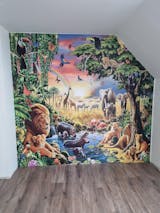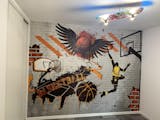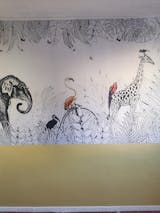Take off from wallpaper on placo can be a difficult task, especially if you don't know the proper tips and techniques.
In this article, we will explore the different methods for removing wallpaper from placo, as well as the pros and cons of each technique.
That you had to remove wallpaper from placo without undercoat or remove hard-to-peel wallpaper, we have the advice you need.
Removing wallpaper from placo without undercoat: is it possible?
Tip for removing wallpaper from placo without undercoat
If your wallpaper is stuck directly onto placo Without an undercoat, this can make the task more difficult. However, it is possible to remove wallpaper with the help of a product remove wallpaper such as the wallpaper stripper.

This product is specially designed to facilitate the removal of wallpaper, even on delicate surfaces such as placo.
To use this product, follow these steps:
- Apply the wallpaper remover to the surface of the paper using a brush or roller.
- Leave the product on for 10 to 15 minutes so that it can penetrate and soften the wallpaper glue.
- Use a spatula or painter's knife to gently peel the wallpaper off the wall.
If you are having trouble removing the wallpaper, you can also try dampening it with warm water and a few drops of dishwashing liquid.
Leave to act for a few minutes, then gently scrape the wallpaper to remove it.
Note that if you are planning to put up new wallpaper, it is best to use a non-woven wallpaper, because it is easier to install and remove
How to remove wallpaper stuck on BA13?

Techniques for removing wallpaper from BA13 placo
BA13 is a type of placo commonly used for the construction of interior partitions. If you need to removing wallpaper from Placoplatre BA13, here are some tips to make the task easier:
- Protect the floor and nearby furniture with plastic sheeting to prevent water and glue from splashing.
- Start by dampening the wallpaper with warm water mixed with dishwashing liquid, using a sponge or a spray bottle. Let it sit for 15 to 20 minutes.
- Use a scraper or spatula to remove the wallpaper, being careful not to damage the placo.
- If the wallpaper is particularly difficult to remove, you can use a wallpaper stripper to make the work easier.
- Once the wallpaper is removed, remove any remaining glue with a damp sponge and dishwashing liquid.
It is important to proceed delicately to avoid damaging the placo. If you need to put up new wallpaper, we recommend using a non-woven wallpaper, which is easier to install and remove.
How to remove difficult wallpaper?

Tips for Removing Stubborn Wallpaper
Sometimes certain wallpapers are particularly difficult to remove.Here are some tips to help you remove wallpaper recalcitrant:
- Use a wire brush or fine-grit sandpaper to lightly scratch the surface of the wallpaper. This will allow the water to penetrate better and soften the glue.
- Apply a solution of equal parts warm water and white vinegar to the wallpaper using a sponge or spray bottle. Let it sit for 20 to 30 minutes.
- Use a scraper or spatula to remove the wallpaper, being careful not to damage the placo.
- Finally, remove any glue residue with a damp sponge and dishwashing liquid or diluted white vinegar.
To avoid difficulties when removing wallpaper, choose a non-woven wallpaper, which is easier to install and remove. In addition, it has many advantages over traditional wallpapers.
How to remove paper stuck to the wall?

Removing wallpaper stuck directly to placo
If the wallpaper has been glued directly to the placo without underlay, it may be more difficult to remove. Here are some tips for remove paper stuck to the wall :
- Protect the floor and furniture with tarps or old sheets.
- Start by lightly dampening the wallpaper with a spray bottle of warm water to soften the glue.
- Use a scraper or spatula to remove the wallpaper, being careful not to damage the placo.
- If the wallpaper is still difficult to remove, apply a solution of hot water and white vinegar or a specific product for removing wallpaper.
- Remove glue residue with a damp sponge and dishwashing liquid or diluted white vinegar.
- After removing the wallpaper, allow the placo to dry for 24 hours before sanding it and applying an undercoat to prepare the wall for new covering.
To make the job easier, opt for a non-woven wallpaper during the next installation. This type of wallpaper is easier to install and remove, and has many benefits compared to traditional wallpapers.






